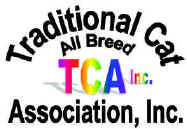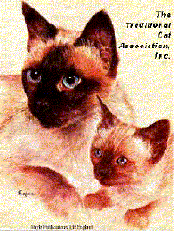
 The
Traditional Cat Association,
Inc.©1987®TM
Official Website
The
Traditional Cat Association,
Inc.©1987®TM
Official Website
Founded 1987, by Diana L.
Fineran
|
" Home of the Traditional Cat"© |
|
Our Motto: To Preserve,
Protect, Perpetuate, and Promote Traditional Cats.© |
|
|
||||
|
|
TRADITIONAL CHARTREUX©® CAT FAQsHISTORY - PERSONALITY -
HEALTH HISTORY The existence of this natural, true blue breed of cat was documented in the 16th century, and its unique color and coat texture was noted. Their name is pronounced shar-true. In French literature it is reported to be a fine mouser. A 1558 poem written by French poet du Balley reads something like this, “It’s Belaud my little gray cat Intriguing are the legends steeped within the breeds history. Curiously one old legend postulates that the Traditional Chartreux lived with, and was named after, the Carthusian Monks at the Le Grand Chartreux Monastery, founded in 1084 by St. Bruno in the French Alps outside Parris, France, and may have shared a sip of their Chartreuse liqueur! In fact, one legend says they were named after the world famous yellow and green Liqueur des Peres Chartreuse. More lore says a brother brought a blue cat home to the monastery from the Cape of Good Hope during the 17th century. Originally the cats were used for mousing. Supposedly they were selectively bred to be soft voiced so the cats would not disturb the monks’ meditations. The monastery records make no mention of cats. There is no way to know if this is true or not and the cats aren’t telling. Yet in the “Universal Dictionary Of Commerce, Natural History, and Of The Arts And Trades,” the following definition of “bluish cats” is given, “This type is called Chartreux because of the monks of this name who owned the first of the breed.” This book, published between 1749 and 1804 possibly is the first mention of the name, Chartreux to describe blue cats from France. Perhaps they trudged along with the crusading knights in the 13th Century as the knights limped home from their ill fated fight against the Turks. Along with them came plundered goods, including the blue cats, which they probably picked up along the African coast. More in line with reality, indications show they were named after a well-known, Spanish wool of the early 18th Century. Even the “Universal Dictionary” defines the word “Chartreux” as a type of Spanish wool! The “Histoire Naturelle”, a 44 volume work written in the 1700’s by biologist, Comte de Buffon lists four cat breeds common in Europe during that century. They are: Domestic, Angora, Spanish and Chartreux. A theory about where the Traditional Chartreux originated was given in “The Chartreux Cat” by Simonnet, “The Chartreux cat probably came from the Near East, and the cat described by the Italian intellectual, Aldrovandi, in the 16th Century, under the name “Cat of Syria” was probably its ancestor; the name was given to this cat because of its origin before it assumed the name Chartreux.” In that same book an illustration of the “Cat Of Syria” shows a stocky cat with solid gray coloring and vivid, slightly almond shaped eyes of copper color. A mouse cowers beside the cat, testifying to the hunting prowess of the cat as well as presenting one of the reasons the breed was so highly prized. Merchant ships brought the Traditional Chartreux to Europe to become an established French cat. In their early days it was a miracle they survived at all, because they were only working farm and street cats, left to fend for themselves without love or care. For a time they were prized for their luxurious pelts! Jean Simonner wrote, “One can truly say that the Chartreux cats beloved to us formerly did not have the best of times with our countrymen.” They certainly are hardy survivors! The Blue coat, along with a robust body and characteristic smile, are the breed’s popular acclaim. Medium in length and wooly, the water repellent coat has a dense undercoat, giving it resistance. The coat is so thick, in fact, it breaks like sheep’s wool at the neck, chest and flanks. The tips are lightly brushed with silver giving a beautiful, iridescent glow to their fur. They are known for their smile, created by the contours of the head, which gives the image of smiling. The Leger sisters were the first to seriously work with the breed beginning in the late 1920’s in their de Guerveur Cattery. Christine and Suzanne Leger noticed a group of Chartreux cats on the small, British, island of Bell Lle, off the coast of France. The free roaming, blue cats lived on the grounds of a hospital in the city of Le Palais. The sisters wrote, “In the first year of our installation at Belle Lle, we were awestruck by the number and beauty of several blue cats with thick coats whom the people at Le Palais called “hospital cats.” One of the sisters wrote in “Country Living”, “In the country we have similarly found these cats, and remarkable they all have the same type and, in spite of cross breeding with the European cats of the country, have kept the characteristics of their breed.” In 1931 the Leger sisters were the first to exhibit their cats in France. World Was II had a profound effect on their numbers. Some French breeders out crossed to Blue Persians, Blue British Shorthairs and Russian Blues to prevent extinction.
|
|
The Traditional Cat Association, Inc.©1987®TM ALL RIGHTS RESERVED © by John & Diana Fineran - Aug 1999- 2025 No portion of this website or any information contained within it may be copied, or in any way distributed, without the expressed written permission of John or Diana Fineran - No exceptions. |